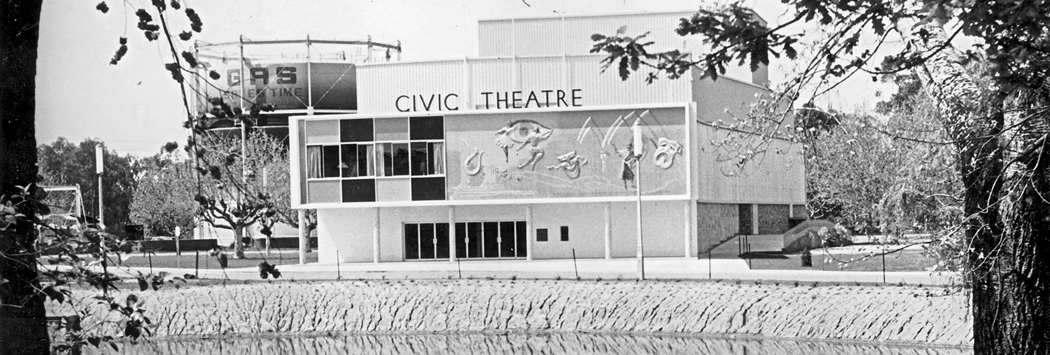
The Wagga Civic Theatre on the Wollundry Lagoon in 1963 - Photo: Alexis J Favenchi
The need for a central public Theatre space was being called for as far back as the 1950's. The many theatrical and artistic organizations throughout the city were using various venues for their individual needs. The Eisteddfod Society was using the Plaza Movie Theatre in Baylis Street, the Wagga Theatre Club was using the Wonderland Theatre for their musicals along with many Wagga Schools for their concerts and musicals which was also a local dance and basketball venue, the Wagga School of Arts Players had clubrooms upstairs in the building on the south west corner of Johnson and Fitzmaurice Streets but mainly presented their productions in St. Andrew's Presbyterian Hall in Cross Street.
The Council of the day determined that a Civic Theatre would be a part of a proposed Civic Centre project for the future that would include a Baby Health Centre, Administrative Offices, New Public Library, Museum and Art Gallery. The complex would cover an area approximately five acres and the first building completed was the Baby Health Centre which was officially opened on 10th November, 1961.
The move was now under way to push for the much needed Civic Theatre, but a problem arose with a shortage of funds for the project which caused the Council to enter into discussions with various organisations in the City that were willing to assist with finance.
The Wagga Wagga School of Arts sold their building and were able to donate £57,358 and in return was to secure a permanent home in the basement of the new Theatre.
The Wagga Wagga and District Chamber of Commerce Community Advancement Fund donated £6,756. Wagga Wagga War Memorial City Hall Building Fund Committee (approx) £6,772.
Mayor's Patriotic and War Fund (for provision of a War Memorial) £1,824.
City Hall Building Reserve Account (Council Funds) £27,290.
Long Term Loans £65,000.
The total cost was estimated to be £165,000.
Stephen J. O'Halloran a Wagga Architect was appointed to design the Theatre and Seibels Bros. Of Wagga were awarded the building contract.
And so the Theatre was begun on the site of the Rose Gardens opposite the Council Gasometer in Tarcutta Street. After the plans were released for public viewing and during the building many features of the project came under severe scrutiny by members of the public. Some people were appalled that their beautiful Rose Garden was being destroyed to make way for a Theatre, others complained through the newspaper that the seating capacity of 497 was far too small for the future needs of the city. (One of the reasons for the figure of 497 was that if the seating had been 500 or more an extra 2,000 pounds would have had to be spent on a fire proof curtain at stage front.) Another area of controversy was the design of the Mural on the front of the Theatre, with many people expressing their opposition or support for it through the newspaper. The Mural artist was Vernon Arthur 'Bim' Hilder MBE.
Despite all the controversy surrounding the building, the potential users of the Theatre eagerly awaited the official opening, and this occurred after many delays finally on Saturday, 29th June, 1963.
The Official Opening and Dedication as a War Memorial was performed by Ald. Ivan J. Jack followed by other supporting speakers. Following the official proceedings a Gala Premiere Performance was presented by the Wagga Wagga School of Arts and The Wagga Theatre Club. The Wagga Wagga School of Arts presented an excerpt from the play "Teahouse of the August Moon" and after the interval The Theatre Club presented a Revue which included music and songs from their soon to open "Oklahoma".
The evening was an exciting and memorable one with all the pomp and ceremony that one would expect on such an occasion. The ladies were dressed in their finest and the gentlemen were of course in black tie.
Tickets for the evening were much sought after and there was some controversy about who was invited and who wasn't. The majority of the seats were taken up with those people who were involved with the building of the Theatre and civic dignitaries.
The Theatre was up and running, and what a busy place it was, with organisations queuing up to have their turn of using it. After a short time, more controversy arose with many complaining about the acoustics of the theatre not being up to the standard, the orchestra pit was too large and too deep, why was the entrance stairwell taking up so much of the best area for seating. Despite all of these shortcomings the Theatre was much appreciated by all who used it and many memorable productions were staged over the next four decades.
The Theatre also had it's moments of glory in the early years, such as a Civic Reception for the newly elected Prime Minister Gough Whitlam and the Country and Western legend Slim Dusty chose the Civic Theatre as the venue to launch one of his successful albums with a photograph of Slim performing on stage on the outside cover.
In 1983 and 2003 the Theatre celebrated it's 20th and 40th Anniversary with suitable entertainment to honour the occasions. During the 20th celebration a time capsule was buried under the pavement outside the front of the Theatre and contains the theatrical history of the first twenty years.
During the 70's and 80's money was spent to rectify a number of the problems within, such as raising the floor of the orchestra pit, building a removable cover for it to enable the performers to be more intimate with their audience with added lighting facilities to assist in achieving this. However, it was not until the late 90's that as part of the new Grand Civic Centre plan that a considerable refurbishment was carried out and this enabled many of the past problems to be eradicated.